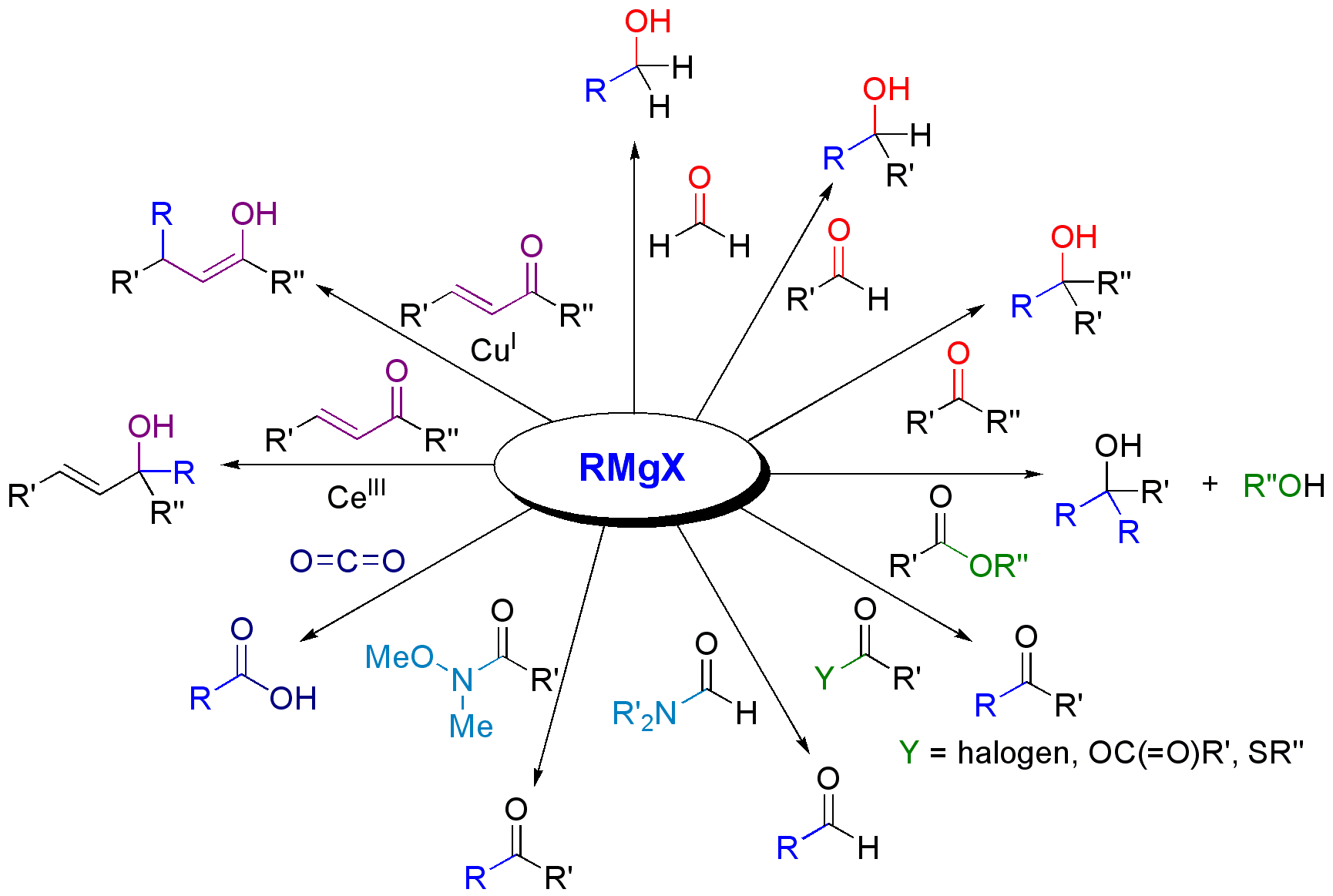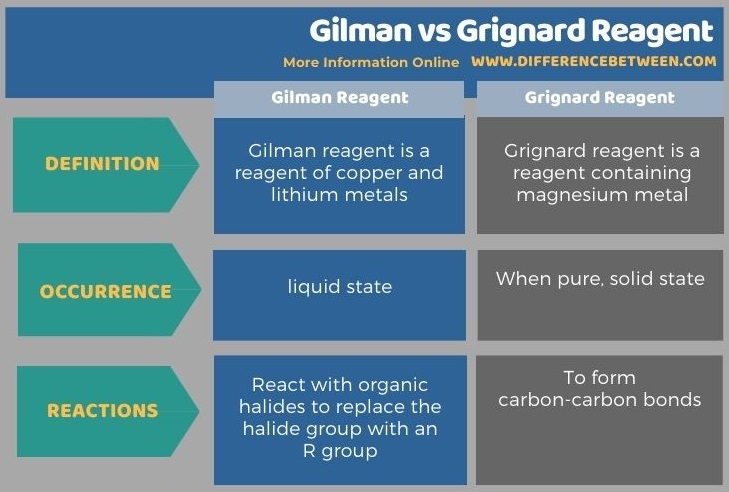Difference Between Gilman and Grignard Reagent
The key difference between Gilman and Grignard reagent is that Gilman reagent is a reagent of copper and lithium, whereas Grignard reagent is a reagent of magnesium.
A reagent is a substance we can add to a reaction mixture in order to cause a chemical reaction or to test if a chemical reaction occurs in a particular system. Gilman reagent and Grignard reagent are such two types of substances.
CONTENTS
1. Overview and Key Difference
2. What is Gilman Reagent
3. What is Grignard Reagent
4. Side by Side Comparison – Gilman vs Grignard Reagent in Tabular Form
5. Summary
What is Gilman Reagent?
Gilman reagent is a reagent of copper and lithium metals. Therefore, we can name it as a diorganocopper substance. The general chemical formula of this substance is R2CuLi. In this chemical formula, R is either an alkyl or an aryl group. This reagent is very useful because unlike some other metallic reagents, Gilman reagent can react with organic halides to replace the halide group with an R group. These types of reactions are named as Corey-House reactions. These replacement reactions are important in the synthesis of complex products from simple building blocks.

Figure 01: General Structure of a Gilman Reagent
This reagent was discovered by the scientist Henry Gilman and his coworkers. A common Gilman reagent is Lithium dimethylcopper having the chemical formula (CH3)2CuLi. We can prepare this reagent via the addition of copper(I) iodide to methyllithium in the presence of tetrahydrofuran at very low temperatures. The product of this reaction exists as a dimer in diethyl ether, forming an eight-membered ring structure.
What is Grignard Reagent?
The Grignard reagent is a reagent containing magnesium metal. The general chemical formula for this substance is R-Mg-X. In this formula, R refers to an organic chemical group, Mg refers to magnesium, and X refers to a halogen. Generally, the R group in this reagent is either an alkyl or an aryl group. There are two typical examples for Grignard reagent; methylmagnesium chloride and phenylmagnesium bromide.
In organic synthesis reactions, Grignard reagents are popular substances. These reagents are helpful in creating new carbon-carbon bonds. E.g. In the reaction between halogenated compound R’-X’ and Grignard reagent in the presence of a suitable catalyst, the end product is R-R’ and the byproduct of the reaction is MgXX’.

Figure 02: Reactions Between Grignard Reagent and Carbonyl Compounds
Moreover, pure Grignard reagents are extremely reactive solid substances. Therefore, we have to handle these substances as solutions in solvents such as diethyl ether or THF. These reagents are stable for some time if the water is excluded from the solution.
What is the Difference Between Gilman and Grignard Reagent?
The key difference between Gilman and Grignard reagent is that the Gilman reagent is a reagent of copper and lithium whereas the Grignard reagent is a reagent of magnesium. Furthermore, the Gilman reagents occur in the liquid state while the Grignard reagents, when pure, occur in the solid-state.
The following infographic summarizes the difference between Gilman and Grignard reagent.

Summary – Gilman vs Grignard Reagent
A reagent is a substance that we can add to a reaction mixture in order to cause a chemical reaction or to test if a chemical reaction occurs in a particular system. The key difference between Gilman and Grignard reagent is that Gilman reagent is a reagent of copper and lithium whereas Grignard reagent is a reagent of magnesium.
Reference:
1. Carey, F. (2008, July 22). Gilman reagent. Encyclopedia Britannica. Retrieved October 07, 2020, Available here.
2. Gilman reagent. Wikipedia. (2020, August 29). Retrieved October 07, 2020, Available here.
Image Courtesy:
1. “Gilman reagent2” By Sidar at English Wikipedia – Transferred from en.wikipedia to Commons by T.vanschaik using CommonsHelper. (Public Domain) via Commons Wikimedia
2. “Grignard with carbony” By Calvero. – Own work, Made with ChemDraw (Public Domain) via Commons Wikimedia
ncG1vNJzZmivp6x7pbXFn5yrnZ6YsqOx07CcnqZemLyue8OinZ%2Bdopq7pLGMm5ytr5Wau26zyKWkmqZdlrulecaroKCmkaexbr7Emp6epqRk